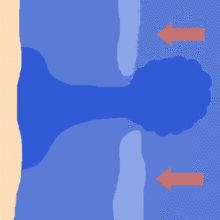This week, state lawmakers will discuss what can be done to better protect people from rip currents on the Great Lakes. It’s estimated that about 30 people drowned in the Great Lakes last year because of rip currents.
Rip currents form when powerful winds or surges of water press along the shoreline. The water must eventually flow back out. When it does the rip current created can prove too strong for even the best swimmer to escape.
Ron Kinnunen is with the Michigan State University extension Sea Grant office. He says rip currents often can be found off the same beaches that attract summer vacationers.
“They’re beautiful sandy beaches. There’s good wave action in those areas. There’s a lot of exposure. So when you do get storms or heavy winds coming across that favor wave action in those areas, that’s when these rip currents tend to be generated.”
Kinnunen says more uniform rip current warning systems would help protect the public.
“We want to look at uniformity for when visitors come to the beach….the same kind of signs….same kind of warning systems.”
He says the deadliest rip currents in the Great Lakes can be found in Lake Michigan and Lake Superior.




